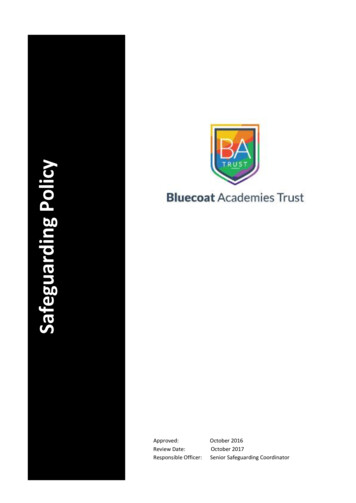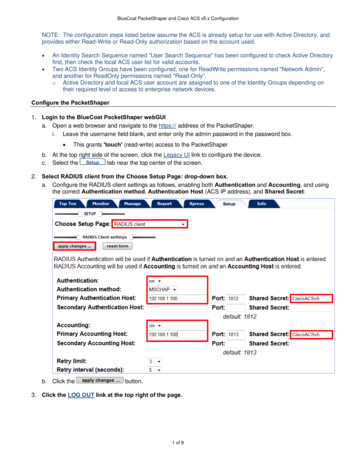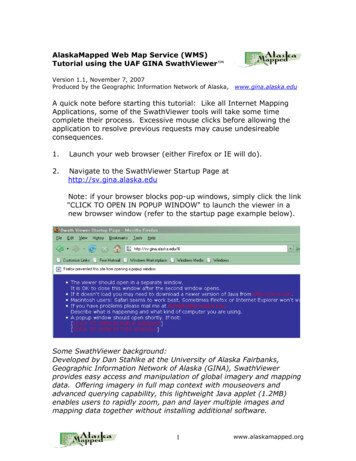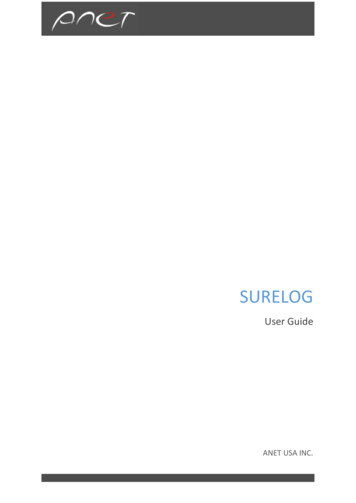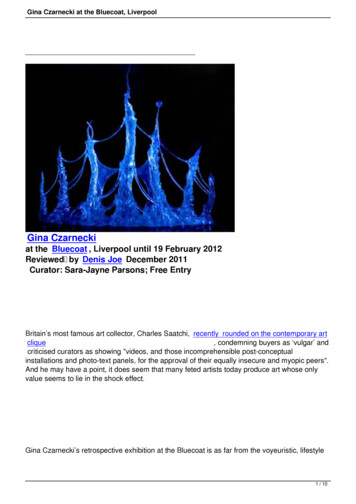
Transcription
Gina Czarnecki at the Bluecoat, LiverpoolGina Czarneckiat the Bluecoat , Liverpool until 19 February 2012Reviewed by Denis Joe December 2011Curator: Sara-Jayne Parsons; Free EntryBritain’s most famous art collector, Charles Saatchi, recently rounded on the contemporary artclique, condemning buyers as ‘vulgar’ andcriticised curators as showing "videos, and those incomprehensible post-conceptualinstallations and photo-text panels, for the approval of their equally insecure and myopic peers".And he may have a point, it does seem that many feted artists today produce art whose onlyvalue seems to lie in the shock effect.Gina Czarnecki’s retrospective exhibition at the Bluecoat is as far from the voyeuristic, lifestyle1 / 10
Gina Czarnecki at the Bluecoat, Liverpoollecturing of Gunther Von Hagens or the ghoulish narcissism of Marc Quinn, as you can get. Inthe series of sculptures, Wasted, which explores the use of human tissue, and includes thecentrepiece of the exhibition,Palaces, we are not confrontedby circus sideshows, for entertainment, but with works that raise the questions of what it meansto be human. In that sense it can be seen as the ideal follow on from the previous exhibition,Democratic Promenade,which focused on the radical interaction between the public and political world. Czarnecki’sopus draws inspiration from the human being: the actual individual body; and how that impactson the social and political world. The work can also be seen as following in the footsteps of theRenaissance artists, in particular Leonardo da Vinci and Michelangelo, whose partnership of artand the natural sciences gave the world some of the most beautiful images that still resonatewhilst, at the same time, questioning the ideas of aesthetics.Quarantine is a work that capture that very humanistic ideal. Using stethoscope recordingsfrom inside the performer’s body mixed with guttural sounds through physical exertion and bodyimpact, breaths, heartbeats and tendons (sound scored by Chris Watson, a founder member ofthe music group Cabaret Voltaire) we are presented with a 40 minute video of the human formput through extreme self-punishment as the body exerts and contorts itself. But there is nosadistic satisfaction to be gained. One can be amazed at, what appears to me, the superhumanstamina of the runner, Rachel Tracey, but one will also be captivated by the beauty of thephysical movements. By capturing human movement under extreme circumstance, the pieceworks as great choreography: pointing to the wonder of human motion.2 / 10
Gina Czarnecki at the Bluecoat, LiverpoolThat same feeling can be gained from another video installation, Infected. Instead of facing thescreen, we look down upon the image (as if looking into a pond) that appears to be theevolution from the stem cell into the fully formed human body. We are confronted with thefeeling that the body is trying to escape its narrow environment. WhilstInfectedposes questions about the physical body, it can also be seen as an existential statement of ourneed to break with the social world, that many of us feel at times.Versifier: Stages Elements Humans is the earliest of Czarnecki’s works in this exhibit, and themost unsettling. A 'wall' of figures, staring straight at the audience span the width of the gallerywindows. It give the gallery a reverential, or religious, feel as the display has the same effect asstain glass art in churches. At first the images seem to be standing still, but slowly they begin tomove. The movement was achieved by manipulating digital technology, and we see each figure‘awaken’ and we watch as they try to break out of the narrow confines of the frames each are in.The work has connections with the Human Genome Project (which was staring up at the timethat Czarnecki was working on the piece). The manipulation of pixels raises the question aboutthe manipulation of genes, highlighting the differences that are in each of us and questioningwhat is ‘normal’ or ‘real’. I found it an interesting work from the aspect of today’s obsession withlifestyles that dominate the social-engineering agenda of governments. The never-endingdiktats (dressed up as ‘advice’) that seem to be moving us into a world of uniformity, inparticular over what we put inside our bodies, is at odds with the celebration of differences thatunderpins the thinking of ‘multiculturalism’. There is also a disturbing element of biologicaldeterminism that underpins many of the assumptions of multiculturalism, one only need recallissues around the ‘gay gene’. Revisionists often cited three scientific studies published in theearly 1990s to ‘prove’ that homosexuality is a genetically inherited condition, and the ‘news’ ofthe ‘discovery’ was, initially celebrated by some gay rights organisations (seeThe Myth Of The Gay Gene).I think that Versifier: Stages Elements Humans may have a greater impact than it would havedone back in 1998. Its relevance to the world of today is greater than it was back then and I feelit will remain so for a long time, as it raises that first philosophical concern of what it is to behuman. The disturbing feeling that impresses itself on the viewer may well derive from the worldwe live in rather than the work itself, which is a truly beautiful piece. Beneath3 / 10
Gina Czarnecki at the Bluecoat, LiverpoolVersifier: Stages Elements Humans, laid out on the floor,is the display of dental casts; part of theWastedseries of installations.Diagram For A Summerhousespeaks of identification. DNA has replaced dentures as the means of identifying unknown orunrecognised human bodies. There is a rather humorous twist to the work in that recentlegislation has said that dental casts are unsuitable for land-fill.Spintex is a collaboration film with Ulf Langheinrich . Based on a real-time transition from dayto night. The work was filmed at an open-air night club and other locations in the Ashanti regionof Ghana, where Langheinrich lives, on the Equator, where the transformation from brightsunlight into the black night lasts only fifteen minutes all year round.4 / 10
Gina Czarnecki at the Bluecoat, LiverpoolMany effects were used on this film, some of which throw the viewer into confusion. In onesection we see a beautiful face of a woman. She is part of a crowd, watching a dance. Thefacial expressions are presented to us by the focus on her mouth and we are never quite sure ifthe movement of her lips is a result of her feelings or a result of manipulation of the image. Whatstruck me about this section of the film was how like ultrasound scan imagery it looked. Theslight facial movements are contrasted with the vigorous dancing that the film dissolves into.Throughout, the human focus has a beat to it which diverges with the sedateness of the naturalmove of day into night, at the beginning of the film. The overall approach to Spintex, brought tomy mind,afugue – where we are slightly aware of the repetition, only in this case it is not the repetition ofsound but of movement.In the upstairs gallery is the interactive video installation, Contagion, whose seductive, playfulinterface gradually suggests a powerful work focused on images, perception, surveillance,bio–security and human interaction. This is the UK premiere of the work, which is a triumph oftechnology as much as it is for art. In this work, the tiniest movements of visitors in theinstallation space are tracked and made visible as colours projected on screen; new colours andsounds are created as visitors' paths coincide. We are led to contemplate our own roles ofcause and effect within the installation. The work draws parallels between the biological spreadof diseases and the dissemination of information, ideas and beliefs and uses a quote fromStephen Corbett, Head of Public Health, Sydney, Australia: “The fear of the pandemic is morelethal that the pandemic itself”.I am not normally impressed by interactive works, I feel that it is, generally, a lazy means ofdrawing the crowds, and most seem to serve no other purpose than to entertain. But Contagionis an important piece. It seems to move away from the idea of the individual/social relationshipand raise reflections on the wider, public, domain. I didn’t interact with the piece myself butwatched a couple of children interacting. A woman, who I assume was their mother, stoodoutside of the arena, then a man, obviously the father, entered it and started moving around,showing the children what was happening on screen. The debate that this piece raises iscertainly important, but will it ever answer the question why fathers feel so insecure that theyhave to assert their authority even when it is inappropriate (rather like your Dad dancing withyour friends at your birthday party)?5 / 10
Gina Czarnecki at the Bluecoat, LiverpoolDownstairs, in the main gallery, we find more from the Wasted collection. The obvious issueshere are those of recycling. But not simply the petty concerns about shopping bags and wastepaper, Czarnecki confronts us with the recycling of human waste products. This is somethingthat many people might not care to address, especially when we are confronted with an art decoarmchair that has a very comfortable looking cushion made from human fats, or a crepe madefrom human fats. It is to Czarnecki’s credit that she chooses to make her point by using amaterial that most people would feel squeamish about. Perhaps no other substance will raise a‘yuck!’ these days than fats and human fats in particular.Trophies of Empire comprises two objects resembling a stalagmite and a stalactite, containedwithin a large clear Perspex cylinder. One is made of growing salt crystals, the other of sugar,solidified like amber. Contained within both are clusters of engraved femoral heads. Sugar andsalt are both used as preservatives and corrosives. The work has deep local significance inLiverpool, not only in the use of body parts and issues relating to permissions but also links withthe history of the local international trade route to the Caribbean and Africa with sugar (Tate)and the Cheshire salt mines.Trophies has also been developedspecifically in relation to the history of the Bluecoat and is co-commissioned by them.6 / 10
Gina Czarnecki at the Bluecoat, LiverpoolCzarnecki‟s Palaces sculpture has been commissioned by The Bluecoat. It represents a uniquecollaboration between Czarnecki and the biologist Professor Sara Rankin from Imperial CollegeLondon. One is immediately taken in by how beautiful the work is. It has a look of spontaneityabout it, as if the shape's details came about by accident through the process. But the drawingsfor the preparation of the work, that are displayed in the gallery, suggest otherwise.Czarnecki has said of this work: “For me, the Palaces project is like the ‘tip of the iceberg Its aesthetic – playful impact of theobject – is critical, yet the actual artwork is not the object, but the process, a signifier of massparticipation.Under the surface there are multiple levels on which this can be read[my emphasis]”.Children from all over the UK have been donating their milk teeth to a resin sculpture, tostimulate a debate on the regenerative potential of stem cells. It is on this point that I have myconcerns about this exhibition. Whilst art will raise issues of a political/social/public nature, I amnot comfortable with the idea that this is the primary aim of art. Art should allow us to reflect onourselves: how we view ourselves as individuals and how we see the world. Our reflections onlife are the very thing that contribute to debate. If art feels that it is setting an agenda for debatethen it simply becomes an extension of what should be the role of politics, and in doing so, itgets our elected officials off the hook.Over the past twenty years or so governments and the media have demanded that footballersbecome role models, soap operas parrot the latest thinking on lifestyles and that painting orwriting contribute to our wellbeing. Funding for the arts requires artists and organisations tomeet a requirement that their work serves some public or social good. It diminishes the role ofthe artist as a visionary and so, denigrates art in general to a simple function of a stickingplaster. If art is to mean anything it cannot anchor itself to contemporary concerns; its relevanceshould outlive the inspiration.7 / 10
Gina Czarnecki at the Bluecoat, LiverpoolIn the Wasted group of installations, Czarnecki not only draws on biology for inspiration but alsopoints to the bureaucracy that poisons much of modern life. Permission slips are displayed thatspeak of the lack of trust that has entered into public life, particular since the Alder Hey organsscandal, and the public enquiry that led to the Human Tissue Act 2004. The major change in theart world, over the past quarter of a century has taken place in the role that it serves. No longerare we trusted to appreciate it as something that enriches us as individual human beings, weare expected take away a lesson from it.My experience at the packed premiere of this exhibition leads me to believe that people attendevents such as this, not to learn, but to marvel. Gina Czarnecki shows herself, first andforemost, to be an important artist. That she can fill the galleries of The Bluecoat withthought-provoking and beautiful works, is a great achievement. Perhaps the only ‘awareness’that we need is just that. Thanks to Bryan Biggs and Ria, a volunteer worker, who helped putsome things into perspective for me.Further events around this exhibition:Chris Watson - Quarantine: Fri 27 January 7.30 – 9.30pmFounder member of influential Sheffield based music group Cabaret Voltaire, Chris Watsonis one of the world‟s leading recorders of wildlife and natural phenomena. Here Chris Watsonpresents the UK premiere of new album El Tren Fantasma and a live performance of his soundscore forQuarantine, (Free butbooking required)Iona Kewney with Joseph Quimby: Sat 28 January 7.30 – 9.30pmA collaboration in movement and sound, pushing physical boundaries and exploring the8 / 10
Gina Czarnecki at the Bluecoat, Liverpoollimitations of the senses. Performing solo for 15 years, Iona Kewney has developed anidiosyncratic style that mixes dance, live music, texts, drawings and physical movement. Shefeatures in Quarantine and Infected. (Free but booking required)Meet the artist: Sat 4 February 2-3.30pmGina Czarnecki will be working on the Palaces sculpture and is free to answer your questions.A great opportunity to find out more about this unique artwork. (Free, just turn up)Pernille Spence NaCI: Sat 4 February 4.30 – 5.30pmStanding in a glass tank, an almost motionless body will gradually be buried under one ton ofsalt, chosen for its loaded political and economic history and the striking contradictions such abasic but beautiful substance holds. Performed by Pernille Spence, a visual, new media andperformance artist, whose practice explores a visual dialogue between the human body,movement and space, and the body's physical/psychological limits and constraints withinspecific parameters. (Free but booking required)Gallery talk by Sara Rankin: Everything you need to know about stem cells - a beginner’sguide for the non-scientist: Weds 8 February, 4.30-5.30pmSara Rankin, Professor in Leukocyte and Stem Cell Biology at Imperial College London, iscurrently researching how stem cells could be the key to tissue regeneration. For several yearsnow she has collaborated with artist Gina Czarnecki on the research and creation of Wasted, aseries of sculptures that explore the use of human tissue in art, the life-giving potential of„discarded‟ body parts and their relationship to myths and history. (Free but booking required)Should living people be able to donate their own human tissue to art?: Weds 8 February6.00-7.30pm9 / 10
Gina Czarnecki at the Bluecoat, LiverpoolJoin artist Gina Czarnecki, Roger Phillips (BBC Merseyside) and guest speakers, includingSara Rankin for this timely debate. The audience will be able to comment and ask questions.(Free but booking required)Palaces will tour to the Science Museum, Imperial College London and the Centre of the Cell,London in 2012, and the Herbert Art Gallery & Museum, Coventry in 2013.10 / 10
Gina Czarnecki's retrospective exhibition at the Bluecoat is as far from the voyeuristic, lifestyle 1 / 10. Gina Czarnecki at the Bluecoat, Liverpool . bio-security and human interaction. This is the UK premiere of the work, which is a triumph of technology as much as it is for art. In this work, the tiniest movements of visitors in the


